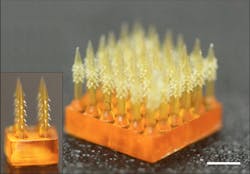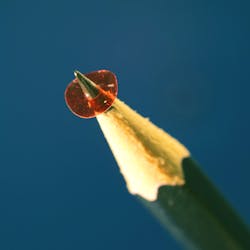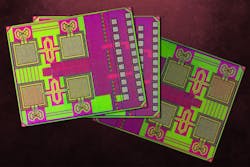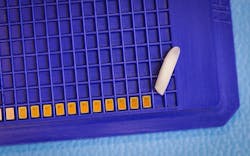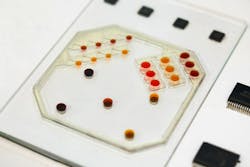When it comes to engineering new ideas and inventions, bigger isn’t always better. Genuinely good ideas have more to do with reaching maximum potential than reaching maximum size. From 4D-printed microneedles to miniature motors and tiny chips, we’ve curated five minute inventions with enormous potential.
1. 4D-Printed Microneedles Eliminate Pain
Patients unhappy with the pain and anxiety from hypodermic needles can breathe a sigh of relief. Rutgers engineers are working on creating a minimally invasive, pain‐free and easy‐to‐use microneedle that mimics parasites that attach to tissues. The 4D-printed microneedle array, with a length‐scale of hundreds of micrometers, are designed to interlock with tissue when inserted, enhancing adhesion, according to a study in the journal Advanced Functional Materials.
Inspiration for the design came from the microhooks of parasites, barbed stingers of honeybees and scaled quills of porcupines, said the study’s lead author Howon Lee, an assistant professor in the Department of Mechanical and Aerospace Engineering in the School of Engineering at Rutgers University-New Brunswick.
Whereas 3D printing is a layer-by-layer fabrication of an object, 4D printing adds a fourth dimension: time. Lee explained that 4D printing allows the material to transform in a pre-programmed way in response to a stimulus. “In this study we programmed or adjusted our manufacturing and material parameters in such a way that the horizontally-printed feature can morph into a backwards-facing barb. So, once the needle is inserted into a tissue, that backward-facing barb can make mechanical interlocking with the tissue. It actually enhances the tissue adhesion of the microneedle.”
Lee noted that creating microfeatures—such as getting the downward-facing barb with a sharp edge—is extremely challenging to fabricate or manufacture with existing manufacturing methods, including microscale 3D printing. In this case the researchers used chicken muscle tissue as a model, and were able to show that tissue adhesion with their microneedle is 18 times stronger than with a barbless microneedle.
Lee hopes the microneedle will replace the painful hypodermic needles and envisions further uses for the invention as a long-term product-delivery tool or a micro-patch in monitoring bio fluids, such as glucose concentration.
2. Five-Millimeter Diameter Motor Powered by Light
The typical rotary motor consists of multiple elements, so miniaturizing it is no easy feat. To tackle the idea, researchers managed to develop a tiny motor with a 5-millimeter diameter ring that’s driven and controlled by a laser beam.
The motor can perform work by rotating another element installed on the same axis, according to researchers at the Faculty of Physics at the University of Warsaw and colleagues from Poland and China.
They achieved their goal by using liquid crystal elastomers (LCE), a group of smart materials that enable construction of small, moving or mobile devices, to demonstrate a rotary micromotor powered with light. The materials are labeled “smart” for their ability to exhibit macroscopic, fast, reversible shape change under different stimuli, including illumination with visible light, noted the researchers.
The design was inspired by ring piezoelectric motors, often found in autofocus mechanisms of photographic lenses. “They can be fabricated in various forms in the micro- and millimeter scales and, by molecular orientation engineering, they can perform complex modes of actuation,” noted the study.
What’s it good for? “Despite low speed, around one rotation per minute, our motor allows us to look at the micromechanics of intelligent soft materials from a different perspective and gives food for thought when it comes to their potential use,” said Dr. Klaudia Dradrach from the Photonic Nanostructure Facility.
3. Tiny, Battery-Free ID Chip Protects the Supply Chain
Tracking authentic goods with radio-frequency identification (RFID) tags can be onerous, not to mention the increased manufacturing costs that come with bulky packaging that don’t fit tiny assets.
Is it any wonder counterfeit goods cost companies a whopping $600 billion dollars annually, according to a private watchdog.
MIT researchers came up with a millimeter-sized ID chip that’s small enough to fit on virtually any product. The invention promises to make tracking the logistics of small objects—a single bolt or tooth implant or silicon chip—a cinch.
“We built a low-cost, tiny chip without packaging, batteries or other external components that stores and transmits sensitive data,” said the study’s co-author Ruonan Han, an associate professor in the Department of Electrical Engineering and Computer Science and head of the Terahertz Integrated Electronics Group in the Microsystems Technology Laboratories at MIT.
The chip runs on relatively low levels of power supplied by photovoltaic diodes. It also transmits data at far ranges, using a power-free “backscatter” technique that operates at a frequency hundreds of times higher than RFIDs.
The chip can also verify authenticity. The chip runs on relatively low levels of power supplied by photovoltaic diodes, explain the researchers. It transmits data at far ranges, using a power-free “backscatter” technique that operates at a frequency hundreds of times higher than RFIDs.
Included in its specs: Communication is in the high terahertz frequency between microwave and infrared radiation—around 100 gigahertz and 10 terahertz—which enables chip integration of an antenna array and wireless communications at greater reader distances. For security, it includes cryptographic protocols because RFID tags can be scanned by essentially any reader and transmit their data indiscriminately, noted the study.
What’s the catch? “It’s a pretty big system integration,” co-author Mohamed I. Ibrahim said, but a worthy trade-off that puts everything on a monolithic silicon chip that’s only about 1.6 square millimeters.
4. Ultra-Low Power Wi-Fi Connectivity for IoT Devices
Electrical engineers at the University of California San Diego developed a new ultra-low power Wi-Fi radio housed in a chip smaller than a grain of rice.
The chip enables Internet of Things (IoT) devices to communicate with existing Wi-Fi networks using 5,000 times less power than current Wi-Fi radios. It consumes just 28 microwatts of power to transmit data at a rate of 2 megabits per second (a connection fast enough to stream music and most YouTube videos) over a range of up to 21 meters, noted the researchers.
The chip could last for years on a single coin cell battery, said Dinesh Bharadia, a professor of electrical and computer engineering at the UC San Diego Jacobs School of Engineering.
“You can connect your phone, your smart devices, even small cameras or various sensors to this chip, and it can directly send data from these devices to a Wi-Fi access point near you,” said Bharadia.
How does it work? Wi-Fi radio runs on extremely low power by transmitting data via a technique called backscattering, said the researchers. “It catches incoming Wi-Fi signals from a nearby device (such as a smartphone) or Wi-Fi access point, modifies the signals and encodes its own data onto them, and then reflects the new signals onto a different Wi-Fi channel to another device or access point.”
5. Miniaturized “Warehouse Robots” for Faster, Automated Blood Diagnostics
Minuscule warehouse logistics robots could help expedite and automate medical diagnostic technologies that move and manipulate tiny drops of fluid.
Dubbed “ferrobots” by a UCLA team of engineers, the robots are disc-shaped magnets about 2 millimeters in diameter. They are designed to work together to move and manipulate droplets of blood or other fluids, with precision, report the researchers, who took their cues from networked mobile robot systems in manufacturing and distribution industries.
The team set out to implement the same level of automation and mobility in a microfluidic setting, said Sam Emaminejad, an assistant professor of electrical and computer engineering and the study’s senior author. “Our ‘factory floor’ is much smaller, about the size of your palm, and our goods, the fluid droplets, are as small as a few tenths of a millimeter.”
Watch the ferrobots on the “factory floor ”:
Ferrobots can be programmed to perform massively parallelized and sequential fluidic operations at small-length scales in a collaborative manner, according to the study published in Science Robotics. To control the robots’ motion, electromagnetic tiles in the chip pull the ferrobots along desired paths, “much like using magnets to move metal chess pieces from underneath a chess board.”
The robots can cleave one large droplet of fluid into smaller drops that are equal in volume for consistent testing, as well as move droplets into preloaded testing trays to check for signs of disease, noted the researchers.
About the Author

Rehana Begg
Editor-in-Chief, Machine Design
As Machine Design’s content lead, Rehana Begg is tasked with elevating the voice of the design and multi-disciplinary engineer in the face of digital transformation and engineering innovation. Begg has more than 24 years of editorial experience and has spent the past decade in the trenches of industrial manufacturing, focusing on new technologies, manufacturing innovation and business. Her B2B career has taken her from corporate boardrooms to plant floors and underground mining stopes, covering everything from automation & IIoT, robotics, mechanical design and additive manufacturing to plant operations, maintenance, reliability and continuous improvement. Begg holds an MBA, a Master of Journalism degree, and a BA (Hons.) in Political Science. She is committed to lifelong learning and feeds her passion for innovation in publishing, transparent science and clear communication by attending relevant conferences and seminars/workshops.
Follow Rehana Begg via the following social media handles:
X: @rehanabegg
LinkedIn: @rehanabegg and @MachineDesign

